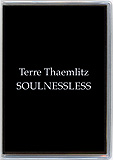|
press プレス |

|
Terre Thaemlitz - Soulnessless - Todd L. Burns |
In Resident Advisor (Australia), December 3 2012.
English | 日本語
★★★★☆
The main chunk of Terre Thaemlitz' Soulnessless is a 29 hour (plus) piano solo rendered as a single mp3. It's labeled "output.mp3," and comes with a text file that explains that the file "currently does not contain track ID (ID3 tag) information... due to the risk of software problems when opening the file for the first time on certain computers." It took me nearly an entire work-week to listen to it.
To be honest, I'm still not sure whether it's good or not. But I'm glad I did it. The solo consists almost completely of Thaemlitz hitting chord after chord with varying degrees of frequency. Listen closely and you'll sometimes hear the strings of the piano or Thaemlitz's body moving this way or that. But listening for slight variations is beside the point when you're dealing with a 29-hour piece of music. There is no increase in tension in hour 17. No jazzy filigree one-fourth of the way through. Thaemlitz ends Soulnessless with a fade out, but you can hear that it finishes the same way that it began―a chord, slowly echoing into nothingness.
What I find most interesting about Soulnessless is that it seems to actually deliver in what it sets out to do. The most precious thing that you can offer something in the 21st century is your attention, and Soulnessless demands it. Even when you dip in for a few hours, the music contained herein leaves you pondering it, and the questions that Thaemlitz has posed with its release: Why have artists done so little to transform their art in the face of the possibilities that the internet and the mp3 affords them? Why do we demand so much "content" from the artists that we love? Why these chords in particular?
In the same way that Thaemlitz describes the piece as a "meditation," I couldn't help but find myself meditating as well. (Thaemlitz hates meditation, but recognizes its value, writing in the notes to the piece that "I resort to it in desperation and protest at the absence of alternate methods for lengthy contemplation.") You don't need to listen to all of the piano solo―the Canto V portion of Soulnessless―but it's worth putting on (and leaving on) and simply seeing what happens. You may find yourself willingly coming back to it again.
When you purchase Soulnessless as a Class 4 MicroSDHC Card, you receive four other Cantos as well as bonus materials. (The bonuses are Thaemlitz' wry joke on the proliferation of "online exclusives" that artists offer up on a regular basis. 29 hours of material just isn't enough.) It would be useless to describe the complex theoretical underpinnings of each. Terre outlines each in lengthy detail in a PDF accompanying the release. It hardly bears mentioning, though, that the various Cantos gain extra resonance when you uncover Terre's relationship with the Virgin Mary and an "unusual summer" with a maternal grandmother. Thaemlitz also presents this text/music in video format, which adds important context for Canto III when Terre visits a convent in the southern Philippines.
It's hard to say which of these Cantos is successful, given their presentation in three different forms. III, as mentioned, works best as a video. II's has digital crickets skittering underneath a pensive drone, and doesn't need images or text at all. (Although Thaemlitz would surely disagree.) IV brings together the religiosity of its predecessors with further computer music alterations, and it's the weakest of the bunch in nearly all formats. As for the bonus material... well... I'll leave that for you to explore yourself. Not because I'm lazy, but more because in not describing them, it seems to keep in line with Thaemlitz's particular concerns: Want to know about the extras? Buy it yourself. I highly recommend it.
|
テーリ・テムリッツ 「ソウルネスレス」ー魂の完全なる不在ー - Todd L. Burns |
In Resident Advisor (Australia), December 3 2012.
English | 日本語
★★★★☆
Terre Thaemlitzによるこの『Soulnessless』の主体は、ひとつのmp3ファイルにまとめ上げられた29時間以上にも及ぶピアノ・ソロ作品だ。"output.mp3"と名前がつけられたファイルとともに、テキスト・ファイルが付属しており、そこにはこう書かれている。「特定のコンピューターでこのファイルを開く際に起こる問題を避けるため、現状のところはトラックID(ID3タグ)は含まれていません」。私は、この作品すべてを聴き通すのにほぼ1週間ほどの時間がかかった。
実際のところ、この作品を聴くのにそれほどの長い時間をかけたことが良かったのか悪かったのかはわからない。少なくとも、聴き通した私には確かな満足感があった。このピアノ・ソロにおいて、Thaemlitzはあらゆる深さのフリークエンシーをもって次から次にコードを重ねていく。注意深く聴いていると、ピアノの弦の音が聴こえ、Thaemlitzの肉体の動くさますら目に浮かんできそうだ。しかし、この29時間にも及ぶ作品を聴こうとする時、微細なヴァリエーションの変化だけにとらわれていると作品の本質を見逃すことになるかもしれない。17時間ほどのあいだはほとんどテンションの変化は見られないし、前半の1/4まではジャジーな展開はまったく無い。この作品はフェード・アウトで終わるが、作品の始まりも同様にフェード・インで始まる。ひたすら、ひとつのコードがゆっくりと無の空間に溶け込んでいくだけだ。
この『Soulnessless』で最も興味深い点は、その出発点と着地点がほぼ同じ場所であるということだ。この21世紀という時代に何かを提示しようとするとき、もっとも貴重なものはリスナー自身の集中力だ。この作品が要求するものは、まさにそうしたリスナー自身の集中力なのだ。この作品を1時間ほど聴いただけでも、その音楽そのものはリスナーに疑問を投げかけている。そして、リスナーはThaemlitzがこの作品を通して何を伝えようとしているのかについて思索を巡らすだろう。芸術がインターネットと出会い、mp3というものが存在しながら、なぜアーティストたちは芸術そのものに大きな変化を起こそうとはしなかったのか?好きなアーティストに対し、我々は「内容」というものを過度に期待し過ぎているのではないのか?そして、これらのコードにおける必然性は……?
Thaemlitz自身はこの作品をひとつの「瞑想」として表現しているが、私自身もこの作品を聴いているあいだ自分が瞑想状態に入っていることを幾度となく認識した(Thaemlitz自身は瞑想という言葉は嫌っているそうだが、その価値自体は認めている。)この作品の説明にはこう書かれている。「これはわたしにとって、瞑想以外に長時間の黙考のための選択肢がないということに対しての絶望であり、抗議でもあるのです」と。かならずしも、ピアノ・ソロ(Canto Vと題された部分)をすべて聴き通す必要はないが、この作品をなんとなくかけ流して、そのまま漠然と何が起こるのか注意を向けておくだけでも価値がある。きっと、思わずもう一度聴き返したくなる瞬間があるはずだ。
クラス4のマイクロSDHCカードとしてこの作品を購入すると、ボーナスとして他の4ヴァージョンの"Cantos"を入手することができる(これは、他の多くのアーティストが「オンライン・ボーナス」というかたちを蔓延させていることについてのThaemlitz自身の皮肉めいたジョークだろう。そもそも、本編だけで29時間も収録されているのだから、ボーナスなどは蛇足にすぎないのだろう)。この作品でのそれぞれパートにおける複雑な理論的基盤を論じるのは無用なことだ。Thaemlitzはそれぞれのパートにおける概要を、リリースに付属した長文のPDFにおいて説明している。ここではその引用は避けるが、ThaemlitzとVirgin Maryという存在とのあいだにある関係性、そして母方の祖母と過ごした「いつもと違う夏」を軸としたそのテキストを踏まえれば"Cantos"はさらなるひとつの調和した全体となって響いてくるだろう。また、Thaemlitzはヴィデオ・フォーマットでテキストと音楽の両方を提示しており、"Canto III"では彼が南フィリピンの修道院を訪ねたことが重要なコンテクストとして浮かび上がってくる。
大きく分けて3部構成となっている"Cantos"はそれぞれ個別に異なるフォームで提示されているので、善し悪しをつけることは難しいが、前述のようにこの作品はヴィデオ形式で鑑賞することが最善の方法だろう。"Canto II"では沈鬱なドローンの下で電気仕掛けのコオロギが素早く動いているようであり、そこにはイメージやテキストといったものは必要ないだろう(Thaemlitzはこの見解には反論するはずだが)。"Canto IV"はそれまでの宗教性を帯びたテーマはそのままに、さらに電子音楽的な加工と変調が施されており、すべてのフォーマット全体を含めた本作品の中ではもっとも印象が薄い部分でもある。ボーナス・マテリアルについてここで説明するのは止めておこう。べつに横着をしているわけではないのだが、私がこれについて説明するよりもThaemlitz自身の言葉を直接読み取ったほうが遥かに理にかなっているからだ。それを知りたければ、あなた自身がこの作品を購入するしかない。少なくとも、私はそれを強く勧める。